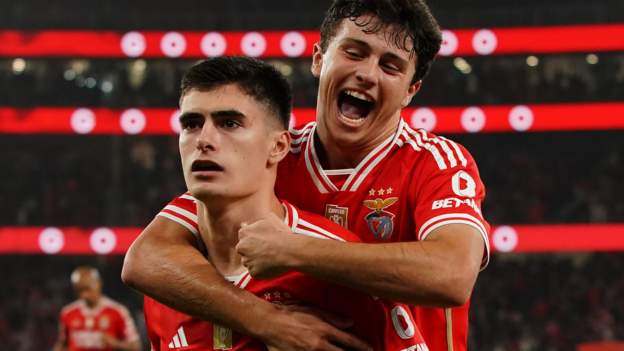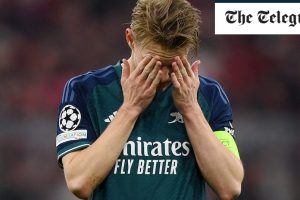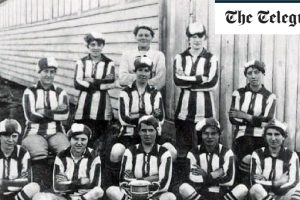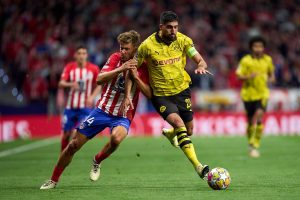
Joao Felix (left) and Ruben Dias (right) inspired Benfica to the league title in 2019 before being sold for fees totalling £170m
Benfica are the reigning Portuguese champions, are a point behind leaders Sporting in a two-horse race for this season’s title and are in the last 16 of the Europa League.
But none of this matters to Pedro Mil-Homens.
As director of Benfica’s youth academy, Mil-Homens’ job is not to worry about beating Porto or Sporting to the title or progressing in Europe. His primary concern is to ensure the club produces the best young talent in Portugal.
The Benfica side that will face Rangers is likely to contain at least three players who have passed through those doors: defender Antonio Silva and midfielders Joao Neves and Florentino.
“We all like to win trophies but our real trophies, the important ones, are seeing our [youth] players in the first team,” says Mil-Homens.
“Not just reaching the team but showing the quality and capacity to stay there for a long period of time. Being able to show they are prepared, that they have the quality, the mentality, the performance to be on that level. When everything happens like that I can relax on the sofa and say we have accomplished our mission.”
Benfica’s academy has another objective, one Mil-Homens does not shy away from: to produce players the club can sell at a high price to fund transfers for experienced players.
In 2022, the CIES Football Observatory declared Benfica’s academy the most profitable in the world, generating 379m euros (£336m) since 2015. Real Madrid was ranked second with 330m euros, with Monaco third on 285m euros.
In 2019 Benfica sold Joao Felix, who had only one full season in the first team, to Atletico Madrid for a club record £115m.
A year later they pocketed £65m for selling Ruben Dias, who joined the club aged 13, to Manchester City.
Dias has three other Benfica alumni as his team-mates at City – goalkeeper Ederson, Bernardo Silva and Joao Cancelo, who joined Bayern Munich on loan last January.
Homegrown players are just one aspect of Benfica’s money-printing operation, which has seen them generate an estimated £1.14bn in transfer sales over the past decade.
A vast network of scouts also helps them unearth players as they are emerging.
Enzo Fernandez, who joined Chelsea for a Premier League record £106m last January, was signed from River Plate for only £15m in summer 2022. Then there is Darwin Nunez, who joined in 2020 for £21m and in 2022 was sold to Liverpool for £85m.
‘We have to be as active as possible’
The Lisbon derby: One of Europe’s fiercest rivalries
One of the key factors behind the success of Benfica’s academy is being able to immerse youngsters in the club’s culture as soon as possible. About 70% of the players the academy sign are aged between six and 12.
To further boost their youth set-up in 2008, Benfica opened four extra academies across the country so players can become part of the club without having to relocate to Lisbon with their families.
It means Benfica compete with fellow top-flight clubs Braga and Porto for the best young talent in the north of Portugal.
Silva and Neves both came through talent centres based outside the capital.
“In greater Lisbon we have two million people and this is not enough in terms of catchment area, so we try to be as active as possible across the country,” Mil-Homens explains.
“Having them for long periods gives us the opportunity to transmit the culture of the club.”
Competitive reserve teams ‘a huge advantage’
When it comes to producing the best youngsters, Benfica and other top Portuguese sides also have one weapon Premier League clubs do not: the opportunity to blood young players in their reserve teams in the competitive environments of the second division.
While Premier League clubs must send their young players out on loan to give them professional experience, Benfica youngsters can cut their teeth in the second division with the B team while still training with the first team.
It is common for players to play for the Under-19 team in the youth league, the B team in the second division and the first team, competing for the top-flight title, all in the same season.
“This is a huge advantage,” says Mil-Homens.
“We try to adjust the training level according to the potential of the player we have in our hands, otherwise it would be a waste of time for them.
“The players like this as they feel they are competing, training in an environment that offers them more rather than if they stayed with their age group.”
‘Mentality makes the difference’
Benfica gives players the tools to succeed, but only a select few remain in the first team or succeed in Europe’s top leagues.
Since Mil-Homens joined the club, two players in particular have stood out – Dias and Joao Felix.
But it surely will not be long before Silva follows Joao Felix and Dias’ paths to Europe’s elite clubs for staggering transfer fees.
Mil-Homens would like to see some players stay a little longer than the one full season Joao Felix had, but he is under no illusions that the academy players who grew up at the club will spend most of their careers elsewhere.
“The perfect condition would be that we have the player in our first team giving us the football performance he’s able to do over a certain number of seasons, and afterwards also giving us the return on our investment,” he says.
“In this industry sometimes there are no rules, there are opportunities and clubs that come and pay the fee they have to pay to bring the player.
“We would like to have them for longer periods but we have to understand sometimes it doesn’t happen.”
A version of this article was first published in March 2023 and updated to reflect Benfica’s Europa League tie against Rangers.






